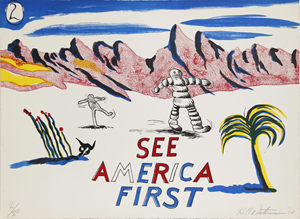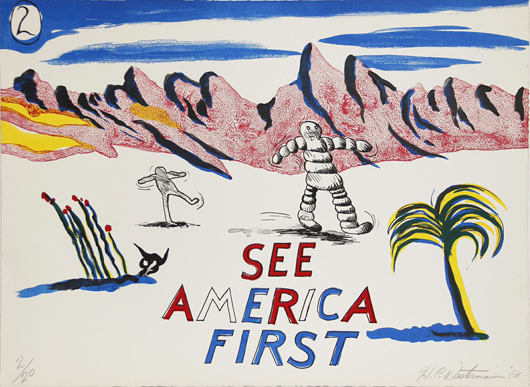
PROVIDENCE, R.I. – The RISD Museum explores an alternate history of contemporary American art this fall in What Nerve! Alternative Figures in American Art, 1960 to the Present. The exhibition opens with a Design the Night celebration on September 18, and an afternoon of Critical Encounters gallery conversations with curators, art historians, and several of the featured artists on September 19. What Nerve! is on view from mid-September through January 4, 2015.
“The RISD Museum is exicited to present this ambitious exhibition,” said John W. Smith, Museum Director. “Both individually and collectively, the artists represented in What Nerve! have had a profound impact on contemporary art — yet, with few exceptions, they remain under-examined. I’m confident that this exhibition and its accompanying catalogue will open up dynamic new conversations within our community and beyond, and bring these artists much deserved attention, scholarly and otherwise.”
What Nerve! traces a history of figurative painting, sculpture, and vernacular imagery that has been largely overlooked and undervalued relative to modernist abstraction and conceptual art. Since the 1960s, many artists working outside New York developed idiosyncratic forms of figuration, unsettling the strict rationales of dominant visual and theoretical trends. When confronted with a system that might seem impenetrable, outsiders often band together, and four important regional gatherings of artists across the nation generated powerful ripples in the art world and beyond.
At the heart of What Nerve! is a re-creation of these four crucial exhibitions, happenings, spaces, and groups: Hairy Who in Chicago, Funk in San Francisco, Destroy All Monsters in Ann Arbor, and Forcefield in Providence. These installations are linked together by six influential or intersecting artists who similarly grappled with figurative and expressive interests. Radiating outward as spokes of connection, these artists —- William Copley, Jack Kirby, Elizabeth Murray, Gary Panter, Christina Ramberg and H.C. Westermann — were markedly influenced by, or a crucial influence on, the four artist groups or hubs at the core of the exhibition.
“The groups and individual artists represented in What Nerve! were not naïve or unaware of the art world around them, they simply trafficked in an alternate history, which is explored in this exhibition and book,” said co-curator Dan Nadel.
All of the artists in What Nerve! ran against the modernist grain and its emphasis on theory. Rather than attempting to compete with mainstream modernism, their influences ran towards comics, folk art, and vernacular signage — as well as the vulgar, profane, and out-of-bounds. Instead of distancing their art through irony or institutional critique, they seized imagery and ideas from vernacular sources as diverse as comics and pottery, pulling and reshaping material from their environments to tackle a variety of subjects with equal doses of satire and sincerity.
Featuring more than 180 paintings, sculptures, drawings, prints, photographs, and videos — as well as ephemera, posters, and other materials featured in reconstructed installations — What Nerve! and its accompanying book represent the first historical examination of the circumstances, relationships, and works of this increasingly important lineage of American artists, and the exuberance, humor, and politics of their artworks remain powerfully resonant.
“In going against the canon, the artists in What Nerve! devised distinctive idioms and created works that are sometimes narrative, often earnest, frequently transgressive, and always individualistic,” said co-curator Judith Tannenbaum. “Exaggerated forms call into question what we know about ourselves, both physically and psychologically.”
Information: 401-454-6500 or risdmuseum.org.
# # #
ADDITIONAL IMAGE OF NOTE



